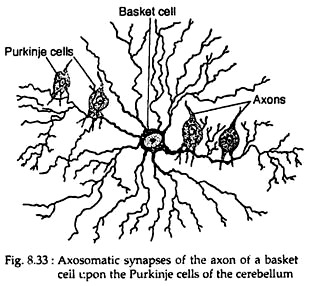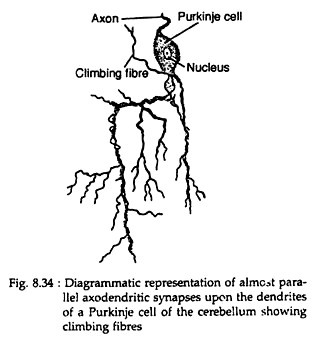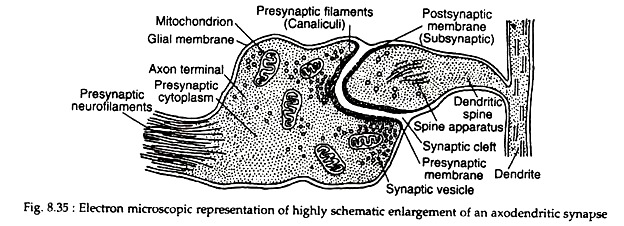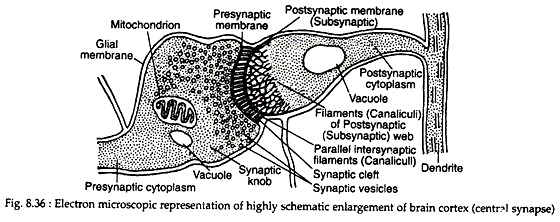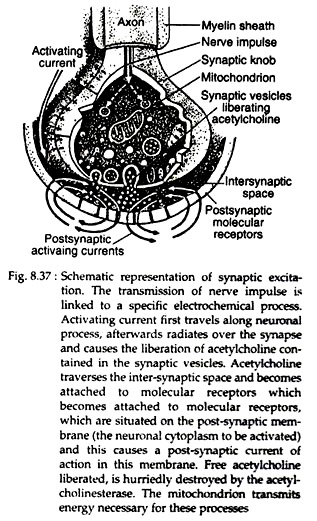In this article we will discuss about:- 1. Meaning of Synapse 2. Classification of Synapse 3. Structure 4. Process of Transmission of Nerve Impulse.
Meaning of Synapse:
According to Sherrington (1898), synapse is the functional connection between two neurons. Therefore, it is the junctional region where one neurone ends and the other begins. Between the pre-synaptic and postsynaptic membranes a cleft of several nanometers is present.
The transfer of information across a synaptic junction is called synaptic transmission. These transmissions are brought about either by chemical or by electrical or by both processes.
Classification of Synapse:
(a) According to structure:
ADVERTISEMENTS:
On the basis of nature of connections between neurones, synapses have been classified into three types:
i) Axosomatic:
The terminal processes of the pre-synaptic neurone end on the cell body or soma of the post-synaptic neurone (Fig. 8.33). This type of synapses is found in the cerebellum between the basket cell and Purkinje cells.
ii) Axodendritic:
ADVERTISEMENTS:
The terminal process of the axon of the pre-synaptic neurone end in the dendrites of the postsynaptic neurone (Fig. 8.34). In the cerebellum, the climbing fibres form connections with the dendrites of the Purkinje cells.
iii) Axoaxonic:
ADVERTISEMENTS:
Here the terminal processes of the pre-synaptic axon make connections with the terminal processes of the axon of the post-synaptic neurone.
(b) According to functions:
On the basis of how one impulse traverse the synapse.
i) Electrical synapse:
Some synapses of mammals transmit stimuli by current flow across adjacent membranes. In this case the neurones are generally in much closer proximity and even in some instances presynaptic arid post-synaptic membranes fused together.
ii) Chemical synapse:
In this case the pre-synaptic membrane release chemical compound (neuro-humor) which is also known as neurotransmitter.
iii) Electrochemical synapse:
In this synapse stimulus transmitted both with the aid of electron and neurotransmitter.
Structure of a Synapse:
ADVERTISEMENTS:
Electron microscopic studies have revealed that the axons of the pre-synaptic neurones end in the expanded terminals – the synaptic or terminal knobs or buttons. The membrane of the synaptic knob is the pre-synaptic membrane while that of the cell body is the post-synaptic membrane. Though there is intimate contact between the two membranes, they are separated by a gap-the synaptic cleft, measuring about 10-20 nm (Fig. 8.35).
Thus, there is no physical continuity in the cytoplasm of the pre-synaptic and post-synaptic neurones at the synapses. However, at some synapses, the two membranes show areas of closer proximity and the outer layers of the unit membranes of the pre- and post-synaptic membranes even fuse, forming gap junctions. In some synapses, the filaments form a web like network on the post-synaptic membrane extending even into the cytoplasm of the post-synaptic neurone. This network is known as the post-synaptic web (Fig. 8.36).
The cytoplasm of the terminal knobs contains mitochondria and synaptic vesicles. The synaptic vesicles are spherical or ovoid shaped with diameters ranging between 20-65 nm. A 4-5 nm thick unit membrane binds the vesicles. These vesicles are more concentrated towards the synaptic cleft.
The synaptic vesicles contain the excitatory neurotransmitter substances that mediate transmission of nerve impulses from the pre-synaptic to post-synaptic neurones. The vesicles may be found on both sides of the synaptic junction, and in electrically transmitting neurones also.
Process of Transmission of Nerve Impulse through Synapse:
The process can be described in two headings.
a. Releasing of chemicals from pre-synaptic knob:
The transfer of nerve impulse across a synaptic junction is known as synaptic transmission. It is believed that the process is brought about by the release of chemical substances at the synapse (Fig. 8.37). The neurotransmitter substances synthesised in the terminal processes of the axons and stored in the synaptic vesicles.
On arrival of nerve action potential through the axon into the terminal knobs, the vesicles release the neurotransmitter substance. Calcium ions are required for the release, and magnesium ions inhibit the process. After the release of the transmitter the vesicular membrane moves into the cell cytoplasm and is used to package new transmitter substances synthesised.
b. Transmission of neurotransmitter from pre-synaptic ending to a post-synaptic membrane:
The neurotransmitter substances released by the pre-synaptic terminal diffuse across the synaptic cleft and bind to specific receptor sites on the post-synaptic membrane. In the vertebrate neuromuscular junction acetylcholine is released from 100 – 300 presynaptic sites and diffuses across a distance of less than 1mm.
Nature of neurotransmitter:
Acetylcholine is one of the major neurotransmitter substance released at the synapse. Among other neurotransmitters sympathin (norepinephrine) in the postganglionic fibres of the sympathetic nervous system is important. Dopamine, 5-hydroxy tryptamine, Ƴ-amino butyric acid (GABA), amino acids like alanine, glycine, aspartic acid and glutamic acid, peptides, histamine and prostaglandin are known to act as neurotransmitters.
Generation of EPSP and IPSP:
The binding of the neurotransmitter to the receptor molecules is accompanied by alteration of the permeability of the postsynaptic membrane. Two types of alterations in the permeability are observed. The first is a general type in which the permeability of post-synaptic membrane to all types of ions bringing about a de-polarisation of the membrane and excitatory postsynaptic potential (EPSP) is produced.
The second type increases the permeability of the membrane to K+ and chloride ions causing hyper-polarisation of the membrane and inhibitory postsynaptic potential (IPSP) is produced. If the synaptic potentials are great enough to produce sufficiently strong local currents, a spike is generated in the appropriate region of the postsynaptic neurone.
Destruction of neurotransmitter substances:
The neurotransmitter substances are destroyed quickly so that normal post-synaptic resting potentials are restored and the neurone may respond again to a new stimulus. Acetylcholine is destroyed by the enzyme acetylcholine esterase at the synaptic junction and produce acetic acid and choline.
